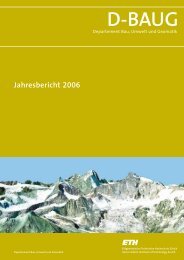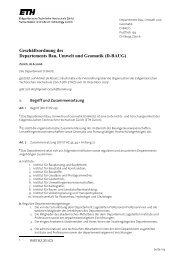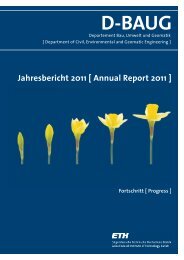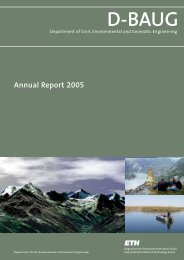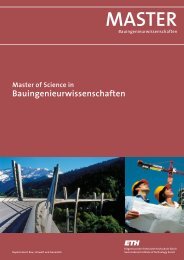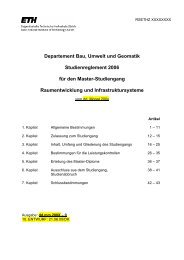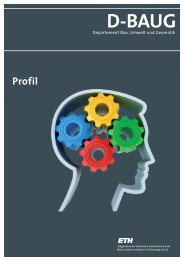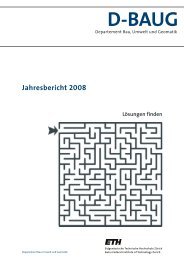D-BAUG - Departement Bau, Umwelt und Geomatik - ETH Zürich
D-BAUG - Departement Bau, Umwelt und Geomatik - ETH Zürich
D-BAUG - Departement Bau, Umwelt und Geomatik - ETH Zürich
Create successful ePaper yourself
Turn your PDF publications into a flip-book with our unique Google optimized e-Paper software.
Highlights ▪ Structures<br />
Air-Coupled Ultraso<strong>und</strong> Inspection of<br />
Glued Timber Components<br />
Non destructive bonding quality assessment<br />
of glued timber products is necessary in order<br />
to prevent security hazards.<br />
by S. J. Sanabria, J. Neuenschwander, U. Sennhauser /<br />
EMPA Dübendorf; P. Niemz / IfB<br />
Air coupled ultraso<strong>und</strong> investigations allowed successful imaging<br />
of glued and non-glued regions with high reproducibility<br />
and spatial accuracy. Glued laminated timber, solid wood panels<br />
and prefabricated wood components currently experience<br />
a strong increase of use in timber constructions; bonding quality<br />
assessment is necessary in order to prevent security hazards.<br />
Air-coupled ultraso<strong>und</strong> (ACU) is a novel non-destructive<br />
method with important improvements in reproducibility and<br />
fine scanning capability with respect to other traditional ultrasonic<br />
technologies used for wood.<br />
As part of an ongoing PhD project,ACU measurements in normal<br />
transmission mode with 120 kHz transducers were performed<br />
on samples consisting of two 5 mm Norway spruce<br />
solid wood lamellas glued together with a polyurethane adhesive,<br />
with artificially introduced delaminated areas. Ultrasonic<br />
scanning with high resolution was performed to image<br />
the presence or absence of glue.The samples were broken up<br />
after measurement and the glued and non-glued regions were<br />
photographed and compared with the ultrasonic amplitude<br />
images.<br />
(Fig. 1) demonstrates successful ACU imaging of glued and<br />
non-glued timber down to a spatial resolution of 20 mm. Ultraso<strong>und</strong><br />
amplitude variations up to 55 dB are observed between<br />
glued and non-glued material,which ensures a reliable<br />
glue line assessment,despite amplitude variations below 8 dB<br />
in bonded regions due to the heterogeneity of wood structure.<br />
The reproducibility of the measurement is below 1.5% after one<br />
year. Future research work is planned to inspect thicker multiple<br />
laminated glued timber structures.The main challenge is<br />
to resolve ultrasonic signal changes between bonded and disbonded<br />
areas from those introduced by wood heterogeneity.<br />
50 ▪ D-<strong>BAUG</strong> Annual Report 2009<br />
Modeling the Growth and Impact of<br />
Wood Decay Fungi<br />
The wood decay fungus P. Vitreus increa-<br />
ses the permeability of wood and thereby<br />
the uptake of wood preservatives.<br />
by M. Fuhr, H.J. Herrmann / IfB<br />
The selective degradation of pit membranes in refractory<br />
wood species e.g. Norway spruce (Picea abies [L.] Kast.) by<br />
the basidiomycete Physisporinus vitreus increases the<br />
permeability of the wood. This process which has been<br />
termed bioincising can be used to improve the uptake of<br />
wood preservatives and environmentally-benign wood<br />
modification substances.The bioincised wood can be used<br />
for a range different industrial purposes.<br />
The objective of this project is to develop a mathematical<br />
model of hyphal growth and expansion of P. vitreus by<br />
means of stochastic processes both in space and time<br />
(Fig. 2). Irreversible growth has been investigated for a long<br />
time in the context of cancer growth, dendritic growth<br />
and gelation and penetration in porous media. In addition,<br />
the project allows to examine degradation patterns of<br />
the fungus and its enzyme activity. By focusing on these<br />
f<strong>und</strong>amental processes, we hope to improve our knowledge<br />
on how the complex system (fungus - wood) interacts<br />
<strong>und</strong>er defined conditions.This information is crucial for the<br />
scaling up of the bioincising process. This work is a joint<br />
project of the two research groups Wood Protection and<br />
Biotechnology, EMPA St. Gallen (Prof. Dr. F.W.M.R. Schwarze)<br />
and Computational Physics for Engineering Materials (Prof.<br />
Dr. H.J. Herrmann).



